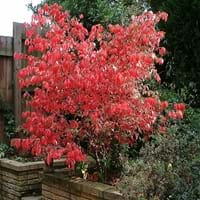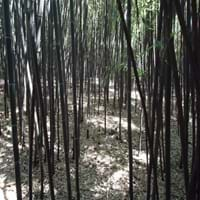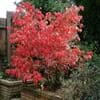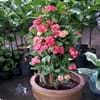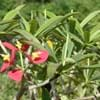Life Span
Perennial
Perennial
Origin
China, Japan, Korea
Southeastern Asia
Types
Dwarf Burning Bush, Rudy Haag, Eastern Woo
Clumping bamboo, Running bamboo, Umbrella bamboo
Number of Varieties
Not Available
Habitat
Dappled Shade, Hedge, Sunny Edge, Woodlands
Subtropical climates, Tropical regions
USDA Hardiness Zone
4-9
9-15
Sunset Zone
A3, 2a, 2b, 3a, 3b, 4, 5, 6, 7, 8, 9, 10, 14, 15, 16
H1, H2, 18, 19, 20, 21, 22, 23, 24
Habit
Spreading
Clump-Forming
Minimum Width
Not Available
Flower Color
Yellow green
Yellow green
Flower Color Modifier
Not Available
Bicolor
Fruit Color
Purple
Non Fruiting Plant
Leaf Color in Spring
Green
Green
Leaf Color in Summer
Dark Green
Light Green
Leaf Color in Fall
Red
Green
Leaf Color in Winter
Not Available
Green
Leaf Shape
Pinnate
Lance shaped
Plant Season
Spring, Summer, Fall
Spring, Summer, Fall, Winter
Sunlight
Full Sun, Partial Sun, Partial shade, Full Shade
Full Sun, Partial Sun
Growth Rate
Fast
Very Fast
Type of Soil
Clay, Loam, Sand
Loam, Sand
The pH of Soil
Acidic, Neutral, Alkaline
Acidic, Neutral, Alkaline
Soil Drainage
Average
Average
Bloom Time
Late Spring
Not Available
Tolerances
Not Available
Cold climate, Drought, Salt
Where to Plant?
Container, Ground, Pot
Ground
How to Plant?
Root Division, Seedlings, Semi-hardwood cuttings
Stem Planting
Plant Maintenance
Medium
Medium
Watering Requirements
Average Water Needs, Do Not over Water, Requires regular watering
Requires regular watering, Water more in summer
In Summer
Lots of watering
Lots of watering
In Spring
Moderate
Moderate
In Winter
Average Water
Average Water
Soil pH
Acidic, Neutral, Alkaline
Acidic, Neutral, Alkaline
Soil Type
Clay, Loam, Sand
Loam, Sand
Soil Drainage Capacity
Average
Average
Sun Exposure
Full Sun, Partial Sun, Partial shade, Full Shade
Full Sun, Partial Sun
Pruning
Prune if you want to improve plant shape, Prune in early spring, Prune in late winter, Prune when plant is dormant, Remove branches, Remove damaged leaves, Remove dead branches, Remove dead leaves, Remove dead or diseased plant parts
No need to prune, Remove damaged leaves, Remove dead branches, Remove dead leaves
Fertilizers
12.5 pounds of a 16-4-8 formula fertilizers, All-Purpose Liquid Fertilizer
All-Purpose Liquid Fertilizer
Pests and Diseases
Red blotch
Aphids, Insects, Red blotch
Plant Tolerance
Not Available
Cold climate, Drought, Salt
Flowers
Insignificant
None
Flower Petal Number
Single
Single
Foliage Texture
Medium
Fine
Foliage Sheen
Matte
Matte
Attracts
Birds
Aphids, Insects
Allergy
Poisonous, Toxic
no allergic reactions
Aesthetic Uses
Showy Purposes
Beautification, Showy Purposes
Beauty Benefits
Not Available
No Beauty Benefits
Environmental Uses
Air purification, Bioremediation of some contaminated sites
Air purification
Medicinal Uses
Anodyne, Anthelmintic, Antiphlogistic, Antipruritic, Astringent, Blood tonic, Cancer, Carminative, Emmenagogue, Hypoglycaemic
No Medicinal Use
Part of Plant Used
Fruits, Leaves
Stem, Tree trunks
Other Uses
Food for animals, Food for insects, Used As Food, Used as Ornamental plant, Used for its medicinal properties, Used for making hedge
Air freshner, Decoration Purposes
Used As Indoor Plant
No
Yes
Used As Outdoor Plant
Yes
Yes
Garden Design
Feature Plant, Hedges, Mixed Border, Screening, Wind Break
Feature Plant, Tropical
Botanical Name
EUONYMUS alatus
BAMBUSA lako
Common Name
Winged euonymus, Burning bush, Winged burning bush, Winged wahoo, Winged spindle-tree
Black Timber Bamboo, Clumping Bamboo, Timor Black Bamboo
In Hindi
Burning Bush Plant
तिमोर काला बांस
In German
Brennender Busch Pflanze
Timor-schwarzer Bambus
In French
Bush brûlant des plantes
Timor bambou noir
In Spanish
La quema de la planta de Bush
Timor Negro de bambú
In Greek
Burning Bush Φυτών
Τιμόρ Μαύρο μπαμπού
In Portuguese
Bush ardente Planta
Timor Black Bamboo
In Polish
Płonącego krzewu roślin
Timor Czarny Bambus
In Latin
Planta flammae rubi
Timor Niger Bamboo
Phylum
Magnoliophyta
Magnoliophyta
Class
Magnoliopsida
Liliopsida
Family
Celastraceae
Poaceae
Clade
Angiosperms, Eudicots, Rosids
Angiosperms, Commelinids, Monocots
Subfamily
Celastroideae
Barnadesioideae
Number of Species
Not Available
Importance of Burning Bush and Timor Black Bamboo
Want to have the most appropriate plant for your garden? You might want to know the importance of Burning Bush and Timor Black Bamboo. Basically, these two plants vary in many aspects. Compare Burning Bush and Timor Black Bamboo as they differ in many characteristics such as their life, care, benefits, facts, etc. Every gardener must at least have the slightest clue about the plants he wants to plant in his garden. Compare their benefits, which differ in many ways like facts and uses. The medicinal use of Burning Bush is Anodyne, Anthelmintic, Antiphlogistic, Antipruritic, Astringent, Blood tonic, Cancer, Carminative, Emmenagogue and Hypoglycaemic whereas of Timor Black Bamboo is No Medicinal Use. Burning Bush has beauty benefits as follows: Not Available while Timor Black Bamboo has beauty benefits as follows: Not Available.
Compare Facts of Burning Bush vs Timor Black Bamboo
How to choose the best garden plant for your garden depending upon its facts? Here garden plant comparison will help you to solve this query. Compare the facts of Burning Bush vs Timor Black Bamboo and know which one to choose. As garden plants have benefits and other uses, allergy is also a major drawback of plants for some people. Allergic reactions of Burning Bush are Poisonous and Toxic whereas of Timor Black Bamboo have no allergic reactions respectively. Having a fruit bearing plant in your garden can be a plus point of your garden. Burning Bush has showy fruits and Timor Black Bamboo has no showy fruits. Also Burning Bush is not flowering and Timor Black Bamboo is not flowering . You can compare Burning Bush and Timor Black Bamboo facts and facts of other plants too.
